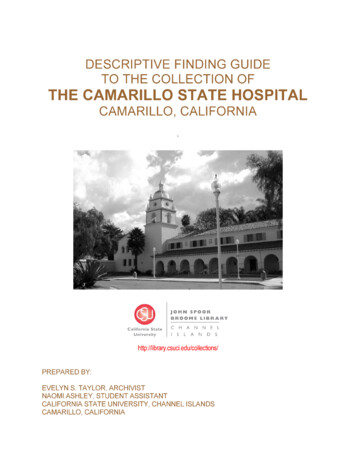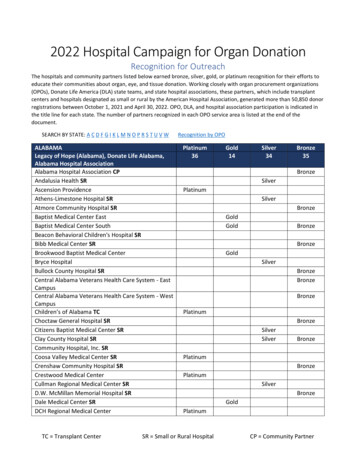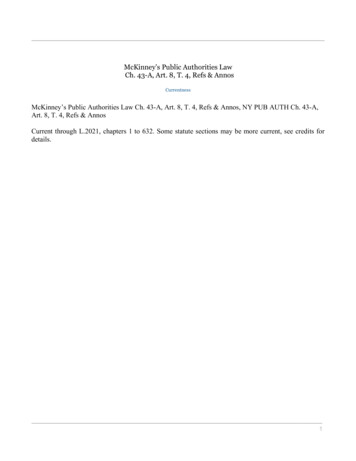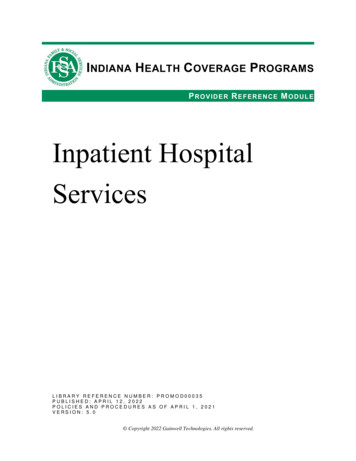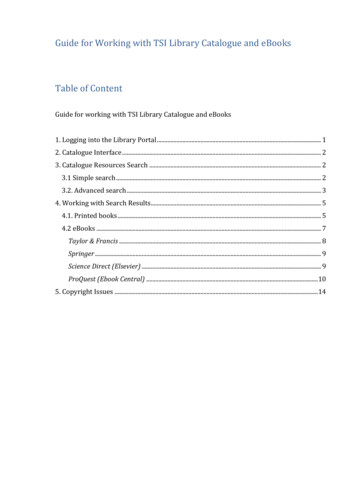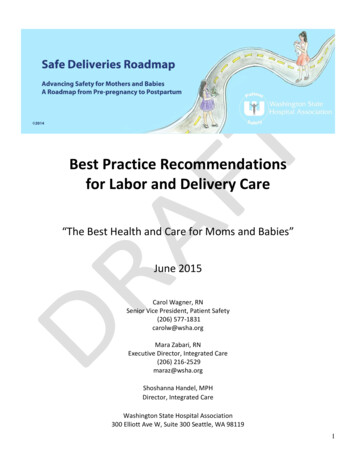
Transcription
Best Practice Recommendationsfor Labor and Delivery Care“The Best Health and Care for Moms and Babies”June 2015Carol Wagner, RNSenior Vice President, Patient Safety(206) 577-1831carolw@wsha.orgMara Zabari, RNExecutive Director, Integrated Care(206) 216-2529maraz@wsha.orgShoshanna Handel, MPHDirector, Integrated CareWashington State Hospital Association300 Elliott Ave W, Suite 300 Seattle, WA 981191
AcknowledgementsSpecial thanks to the following individuals for their expertise and guidance in developing the content of theserecommendations.Content Leads:Tom Benedetti, MD – University of WADale Reisner, MD – Swedish Health ServicesAdvisory Group Members:H. Frank Andersen, MD – Providence Regional Medical Center EverettAmy Bertone, RN, BSN – Providence Sacred Heart Medical Center & Children's HospitalSusan Bishop, RNC-OB, MN – MultiCare Health SystemDeborah Castile MN, RNC, CNS, NE – PeaceHealthAngela Chien, MD – EvergreenHealthAnn Darlington, CNM – retired from Neighborcare HealthJane Ann S Dimer, MD, FACOG – Group Health CooperativeKaty Drennan, MD FACOG – MultiCare Health SystemRita Hsu, MD – Confluence Health, Wenatchee Valley Hospital & ClinicsTracey Kasnic, RN, BSN, MBA, CENP – Confluence HealthEllen Kauffman, MD – Foundation for Health Care QualityDouglas Madsen, MD – PeaceHealthShelora Mangan, DNP, CNS, RNC – Legacy Salmon Creek Medical CenterPatrick Moran, DO – Community Health Centers of Central WA; Central WA Family Medicine Residency ProgramBruce Myers, MD – Mid-Valley Medical GroupDuncan Neilson, MD – Legacy Health SystemPeter E. Nielsen, MD, FACOG – General Leonard Wood Army Community HospitalMolly Parker, MD, MPH – Jefferson HealthcareHelen Phillips, RN – Legacy Health SystemLynn Rhett, RN – Franciscan Health SystemPeter Robilio, MD – CHI Franciscan HealthDeborah Saner, MD – Legacy Salmon Creek Medical CenterBat Sheva Stein, RN, MSN – WA State Dept. of HealthJane Uhlir, MD – Swedish Health SystemsSuzan Walker, RN, MPH – University of WAJames Wallace, MD, MPH – Three Rivers Hospital2
Special thanks to these organizations for their collaboration and support.Supporting Organization Partners:American College of Nurse Midwives – WA affiliateAmerican Congress of Obstetricians and GynecologistsAdvanced Registered Nurse Practitioners United of WA StateAssociation of Women’s Health, Obstetric and Neonatal NursesFoundation for Health Care Quality – OB COAPFoundation for Healthy GenerationsMarch of DimesMidwives Association of Washington StateNorthwest Organization of Nurse ExecutivesPlanned Parenthood - Great NorthwestPlanned Parenthood - Greater WA and North IdahoSeattle University College of NursingUniversity of WA School of NursingWA Academy of Family PhysiciansWA Chapter of the American Academy of PediatricsWA State Department of HealthWA State Health Care AuthorityWA State Medical AssociationWA State Nurses AssociationWA State Perinatal CollaborativeWithinReach3
ContentsIntroduction .5About the Safe Deliveries Roadmap Initiative . Error! Bookmark not defined.Timeline of Activities . Error! Bookmark not defined.How these Recommendations Were Developed . Error! Bookmark not defined.Assumptions Behind the Recommendations . Error! Bookmark not defined.Plan for Updating the Recommendations . Error! Bookmark not defined.Topic 1: Prenatal Care: Assessment of Gestational Age .8Topic 2a: Labor Induction: Pre-Procedure .8Topic 2b: Labor Induction: Non-Medically Indicated .8Topic 2c: Labor Induction: Medically Indicated.8Topic 2d: Labor Induction: Failed Induction (assuming stable mother and fetus)—parameters to use when not enteringactive labor ( 6 cms) .9Topic 3a: Labor- First Stage: Delay Admission to Labor Unit .9Topic 3b: Labor- First Stage: Consider Discharge Home or Further Observation .9Topic 3c: Labor- First Stage: Consider AROM and/or Oxytocin Administration . 10Topic 3d: Labor- First Stage: Consider Cesarean Delivery (All Three Present) . 10Topic 4a: Labor- Second Stage: Assessment of Descent and Position of Presenting Part . 11Topic 4b: Labor- Second Stage: Consider Operative Vaginal Delivery or Cesarean Delivery (If Presenting Part Not OnPerineal Floor: 4 or Lower) . 11Topic 5a: Labor- All Phases: Assessment of Fetal Status . 11Topic 5b: Labor- All Phases: Staffing . 11Topic 5c: Labor- All Phases: Mode of Fetal Monitoring . 12Reference List . 12Appendix A: Guideline Criteria for Non-medically Indicated Labor Induction . 15Appendix B: Assessment of Intrapartum Fetal Heart Rate Tracing Algorithm . 15Appendix C: Algorithm for Management of Category II Fetal Heart Rate Tracings . 164
OverviewCall to ActionThe U.S. is the only developed nation with a rising maternal mortality ratei, and severe maternal morbidities areincreasingly common in recent decadesii. Our infant mortality rate and preterm birth rate are higher than in mostdeveloped countriesiii, iv. These facts persist even though the total amount spent on health care in the U.S. is greaterthan in any other countryv, with childbirth being one of the highest areas of hospitalization costsvi. Although WashingtonState compares favorably to national averages, disparities between sub-populations and suboptimal care scenariospersist, and women and babies continue to suffer preventable morbidity and mortalityvii.Through the Safe Deliveries Roadmap initiative, the Washington State Hospital Association (WSHA) and its partners aimto improve maternal and infant outcomes by establishing and promoting evidence-based* best practices for care acrossfour phases of the perinatal continuum: Pre-pregnancy Pregnancy Labor and Delivery Postpartumi.ii.iii.iv.v.vi.vii.Kassebaum NJ, et. al. Global, regional, and national levels and causes of maternal mortality during 1990–2013: a systematic analysis for the Global Burden of Disease Study 2013. The Lancet. Sept. 2014; 384 (9947):980–1004.Callaghan WM, Creanga AA, Kuklina EV. Severe maternal morbidity among delivery and postpartumhospitalizations in the United States. Obstet Gynecol. Nov. 2012; 120 (5): 1029-36.MacDorman MF, Mathews TJ, Mohangoo AD, Zeitlin J. International comparisons of infant mortality andrelated factors: United States and Europe, 2010. National vital statistics reports. 2014; 63 (5). Hyattsville,MD: National Center for Health Statistics.March of Dimes, PMNCH, Save the Children, WHO. Born Too Soon: The Global Action Report on PretermBirth. Eds Howson CP, Kinney MV, Lawn JE. World Health Organization. Geneva, 2012.Davis K, Stremikis K, Schoen C, Squires D. Mirror, Mirror on the Wall, 2014 Update: How the U.S. Health CareSystem Compares Internationally. June 2014: The Commonwealth Fund.Moore B, Levit K, Elixhauser A. Costs for hospital stays in the United States, 2012. HCUP Statistical Brief#181. October 2014. Agency for Healthcare Research and Quality, Rockville, MD.Washington State Department of Health. Infant mortality. Updated Mar. 7, 2013.About the Safe Deliveries Roadmap RecommendationsThe recommendations are universally relevant for all women and newborns. Recommendations for care specific toselect special populations (those with certain health conditions or making certain health-related choices) that arerelatively common or likely to be subject to variations in current care practices are also included in the “SpecialConsiderations” sections throughout. Physical examinations, patient health self-assessments, and complete health andfamily history-taking are established as foundations of primary care, and therefore are not specified in theserecommendations.5
The recommendations are aspirational – they outline the ideal care for optimal health outcomes. They are meant to beadaptable to the changing healthcare landscape. New care models such as team approaches and telemedicine maysupport implementation of the recommended practices.The recommendations, tips, tools and resources provided in this toolkit reflect the best evidence as of 2014 and theinput of expert clinicians and leaders in health care delivery and public health with expertise in women’s health,obstetrics, midwifery, neonatology, pediatrics, family practice, and health promotion. They will be reviewed andupdated as evidence changes, with a full review planned every 2-3 years.* The Society for Maternal and Fetal Medicine’s grading system /fulltext) wasused as a model; recommendations meeting any level of evidence were allowed to be included.Vision for the Future Women and their families are informed on and engaged in care related to the topics covered by theserecommendations.Providers and healthcare systems identify and meet each patient’s needs to optimize health outcomes.o Care is always culturally appropriate and relevant to each patient. (i.e. Services are responsive topatients’ gender, race/ethnicity, sexual orientation, age, stage, cognitive ability, language, andcultural beliefs.)All women and infants have access to care through coverage and primary care medical/health homes.Health equity and social determinants of health are addressed to enable optimal health attainment.Summary of Labor and Delivery Care Recommendations1. Prenatal Care: Assessment of Gestational Age Provide documentation on how and when gestational age determined.2a. Labor Induction: Pre-Procedure Consent form discussed with patient and signed for any induction; medical and non-medical.2b. Labor Induction: Non-Medically Indicated Not done prior to 39 weeks gestation. Between 39 – 40 6/7 weeks gestation: must have Bishop score of 9 or greater in nulliparous women and 6 orgreater in multiparous women (no cervical ripening).2c. Labor Induction: Medically Indicated Done for reasons that are medically indicated and not included in the non-medically indicated guideline. Cervical ripening if needed for unfavorable cervix.2d. Labor Induction: Failed Induction No cervical change after 24 hours of oxytocin and membranes have been artificially ruptured. Failure to enter active phase despite uterine contractions every 3 mins x 24 hours with ruptured membranes. Inadequate response to 2nd cervical ripening agent and failure to respond to oxytocin per hospital protocol. In the setting of ruptured membranes, no cervical change after 12 hours of oxytocin.3a. Labor – First Stage: Delay Admission to Labor Unit Cervix less than 4 cm. Membranes intact. Reactive nonstress test/fetal heart rate category I (if uterine contractions present) confirmed by 2 practitioners.6
Pain control adequate with appropriate outpatient interventions as neededNote: For spontaneous labor use all recommendations. For induction of labor entering active phase only use lastrecommendation.3b. Labor – First Stage: Consider Discharge Home or Further Observation Cervix 4-5 cm without change x 2 - 4 hours. Less than 80% effacement. Membranes intact. Reactive NST/FHR category I (if uterine contractions present). Contractions less than 3/10 minutes.Note: For spontaneous labor only.3c. Labor – First Stage: Consider Artificial Rupture of Membranes Cervix 4-5 cm without change x 2- 4 hours. 90 – 100% effacement. Membranes intact. Reactive NST/FHR category I (if uterine contractions present). Contractions less than 3/10 minutes.Note: For spontaneous labor only.3d. Labor – First Stage: Consider Cesarean Delivery Cervix 6 cm or greater. Membranes ruptured (if feasible). Arrest of cervical dilation and uterine activity.Note: For spontaneous labor and induction of labor entering active phase.4a. Labor – Second Stage: Assessment of Descent and Position of Presenting Part At least every 1- 2 hours.4b. Labor – Second Stage: Consider Operative Vaginal Delivery or Cesarean Delivery Time from complete dilation:o Nulliparous with epidural anesthesia – 4 hours.o Nulliparous without epidural anesthesia – 3 hours.o Multiparous with epidural – 3 hours.o Multiparous without epidural – 2 hours.ORo Total time from complete dilation 5 hours or greater.o Greater than 2 hrs, adequate pattern, no descent.5a. Labor – All Phases: Assessment of Fetal Status Use FHR interpretation algorithm.5b. Labor – All Phases: Staffing 1:1 nurse to patient staffing ratios in active labor, high risk, or being induced.5c. Labor – All Phases: Mode of Fetal Monitoring Provide ability to palpate contractions and auscultate FHR in appropriate populations.7
Topic 1: Prenatal Care: Assessment of Gestational AgeRecommendations Provide documentation on how and when gestational age determined (most recent American Congress ofObstetricians and Gynecologists (ACOG) criteria, see ACOG Committee Opinion No. 611)Special Considerations 1st trimester ultrasound dating is most accurate when a clearly visualized crown-rump length (CRL) can bemeasured.References(1-11)Topic 2a: Labor Induction: Pre-ProcedureRecommendations Consent form discussed with patient and signed for any induction; medical and non-medical (ACOG inductionconsent or equivalent)References(4; 10; 12-14)Topic 2b: Labor Induction: Non-Medically IndicatedRecommendations Not done prior to 39 weeks gestationBetween 39 – 40 6/7 weeks gestation. Must have Bishop score of 9 or greater in nulliparous women and 6 orgreater in multiparous women (no cervical ripening)References(4; 7; 15-28)Topic 2c: Labor Induction: Medically IndicatedRecommendations Done for reasons that are medically indicated and not included in the non-medically indicated guideline(Appendix A)Cervical ripening if needed for unfavorable cervixReferences(4; 6; 13-14; 16-17; 29-31)8
Topic 2d: Labor Induction: Failed Induction (assuming stable mother and fetus)—parameters to use when not entering active labor ( 6 cms)Recommendations No cervical change after 24 hours of oxytocin and membranes have been artificially ruptured (if feasible and nocontraindications)Failure to enter active phase (6 cms) despite uterine contractions every 3 mins x 24 hours with rupturedmembranesInadequate response to 2nd cervical ripening agent and failure to respond to oxytocin per hospital protocolIn the setting of ruptured membranes, no cervical change after 12 hours of oxytocinSpecial Considerations If failed induction with intact membranes and Group B streptococcus (GBS) negative, discuss options regardingfurther management: consider risks, benefits, and alternatives of all options (i.e: discharge home with plan toreturn versus cesarean section, depending on clinical situation)References(16; 26; 32-36)Topic 3a: Labor- First Stage: Delay Admission to Labor UnitNote: For spontaneous labor use all recommendations. For induction of labor entering active phase only use lastrecommendation.Recommendations Cervix less than 4 cmMembranes intactReactive nonstress test/fetal heart rate (NST/FHR) category I (if uterine contractions present) confirmed by 2practitioners (RN, MD, DO, CNM)Pain control adequate with appropriate outpatient interventions as neededReferences(26)Topic 3b: Labor- First Stage: Consider Discharge Home or Further ObservationNote: For spontaneous labor only.Recommendations Cervix 4-5 cm without change x 2 - 4 hoursLess than 80% effacementMembranes intactReactive NST/FHR category I (if uterine contractions present)Contractions less than 3/10 minutes9
References(26)Topic 3c: Labor- First Stage: Consider Artifical Rupture of Membranes (AROM) and/orOxytocin AdministrationNote: For spontaneous labor only.Recommendations Cervix 4-5 cm without change x 2- 4 hours90 – 100% effacementMembranes intactReactive NST/FHR category I (if uterine contractions present)Contractions less than 3/10 minutesReferences(26; 34-39)Topic 3d: Labor- First Stage: Consider Cesarean Delivery (All Three Present)Note: For spontaneous labor and induction of labor entering active phase.Recommendations Cervix 6 cm or greaterMembranes ruptured (if feasible)Arrest of cervical dilation and uterine activity (see special considerations for parameters)Special Considerations Arrest of cervical dilation and uterine activity documented as:o Adequate ( 200 Montevideo units or palpably strong q 3 minutes when not feasible to rupturemembranes) with no or minimal cervical change x 4hr ***ORo Inadequate ( 200 Montevideo Units or 3/10 minutes despite oxytocin per protocol) with no or minimalcervical change X 6hr****** Clinical judgment is needed to determine safe upper limit of total time allowed in active phase 6cm to 10cm.“Minimal cervical change” would be substantially less than clinical norm, for example, less than or equal to 1 cm changein 4 - 6 hours. Per the Zhang et al. partogram at 6cm the 95th percentile for a normal active labor phase curve andnormal outcomes is approximately 8 hrs total timeReferences(16; 26; 40)10
Topic 4a: Labor- Second Stage: Assessment of Descent and Position of PresentingPartRecommendations At least every 1- 2 hoursReferences(26)Topic 4b: Labor- Second Stage: Consider Operative Vaginal Delivery or CesareanDelivery (If Presenting Part Not On Perineal Floor: 4 or Lower)Recommendations Time from complete dilation*/**:o Nulliparous with epidural anesthesia – 4 hourso Nulliparous without epidural anesthesia – 3 hourso Multiparous with epidural – 3 hourso Multiparous without epidural – 2 hoursORo Total time from complete dilation 5 hours or greatero Greater than 2 hrs, adequate pattern, no descentSpecial Considerations*Passive descent (laboring down) is included in these time periods.** Each may need an additional hour if occiput posterior position and rotation of greater than 45 degrees towardanterior has been previously achieved.References(16; 26)Topic 5a: Labor- All Phases: Assessment of Fetal StatusRecommendations Use FHR interpretation algorithm (e.g. Spong, Clark) (Appendix B and C)References(26)Topic 5b: Labor- All Phases: StaffingRecommendations11
1:1 nurse to patient staffing ratios in active labor (greater than or equal to 6 cm AND 80% effaced) high risk orbeing inducedTopic 5c: Labor- All Phases: Mode of Fetal MonitoringRecommendations Provide ability to palpate contractions and auscultate FHR in appropriate populationsReference List1. Abuhamad AZ. The American College of Obstetricians and Gynecologists. Ultrasonography in pregnancy. PracticeBulletin No. 101. Obstet Gynecol. 2009 Feb; 113 (2 Pt 1): 451-61. Reaffirmed 2011. Retrieved fromhttp://www.ncbi.nlm.nih.gov/pubmed/191559202. American Academy of Pediatrics and The American College of Obstetricians and Gynecologists. Guidelines forPerinatal Care, 7th Edition. 2012. Retrieved from al-CareSeventh-Edition-P729.aspx3. The American College of Obstetricians and Gynecologists. Fetal lung maturity. Practice Bulletin No. 97. ObstetGynecol. 2008 Sep; 112(3): 717-26. Retrieved from http://www.ncbi.nlm.nih.gov/pubmed/187576864. The American College of Obstetricians and Gynecologists. Induction of labor. Practice Bulletin No. 107. ObstetGynecol. 2009 Aug; 114(2 Pt. 1): 386-97. Retrieved from http://www.ncbi.nlm.nih.gov/pubmed/196230035. The American College of Obstetricians and Gynecologists. Method for Estimating Due Date. Committee OpinionNo. 611. Obstet Gynecol. 2014 Oct; 124:863-6. Retrieved from ittee-on-Obstetric-Practice/co611.pdf?dmc 1&ts 20150504T20565722566. The American College of Obstetricians and Gynecologists & Society for Maternal-Fetal Medicine. Medicallyindicated late-preterm and early-term deliveries. Committee Opinion No. 560. Obstet Gynecol. 2013 April;121:908-10. Retrieved from mittee-on-ObstetricPractice/co560.pdf?dmc 1&ts 20150504T20585821037. The American College of Obstetricians and Gynecologists & Society for Maternal-Fetal Medicine. Nonmedicallyindicated early-term deliveries. Committee Opinion No. 561. Obstet Gynecol. 2013 April; 121:911-5. Retrievedfrom mittee-on-ObstetricPractice/co561.pdf?dmc 1&ts 20150504T21004422618. Hadlock FP, Deter RL, Harrist RB, Park SK. Estimating fetal age: Computer-assisted analysis of multiple fetalgrowth parameters. Radiol. 1984 Aug; 152:497-501. Retrieved fromhttp://www.ncbi.nlm.nih.gov/pubmed/67398229. Joint Commission. Perinatal care core measure set. Oakbrook Terrace, IL. 2014 October 16. Retrieved fromhttp://www.jointcommission.org/perinatal care/10. Joint Commission. 2015 Comprehensive accreditation manual for hospitals. Oakbrook Terrace, IL. 2014 Nov.Retrieved from l-for-hospitals-camh-/11. Savitz DA, Terry JW, Dole N, Thorp JM, Siega-Riz AM, Herring AH. Comparison of pregnancy dating by lastmenstrual period, ultrasound scanning and their combination. Am J Obstet Gynecol. 2002; 187(6):1660-66.Retrieved from 7-8/abstract12. The American College of Obstetricians and Gynecologists. Informed consent. Committee Opinion No. 439.Obstet Gynecol. 2009 Aug; 114: 401-8. Retrieved from ittee-on-Ethics/co439.pdf?dmc 1&ts 20150504T211225305612
13. The American College of Obstetricians and Gynecologists. Inpatient induction of labor. Patient Safety ChecklistNo. 2. Obstet Gynecol. 2011; 118:1205-6. Retrieved from ts/psc002.pdf?dmc 1&ts 20150504T211403790114. The American College of Obstetricians and Gynecologists. Scheduling induction of labor. Patient Safety ChecklistNo. 5. Obstet Gynecol 2011 Dec; 118: 1473-4. Retrieved from ts/psc005.pdf?dmc 1&ts 20150504T211403790115. The American College of Obstetricians and Gynecologists. Choosing wisely: Five things physicians and patientsshould question. 2013 Feb 21. Retrieved from s/16. The American College of Obstetricians and Gynecologists. Safe prevention of the primary cesarean delivery.Obstetric Care Consensus No. 1. Obstet Gynecol. 2014 March;123:693–711. Retrieved f-thePrimary-Cesarean-Delivery17. Bishop, EH. Pelvic scoring for elective induction. Obstet Gynecol. 1964; 24(2): 266–268.18. Clark SL, Miller DD, Belfort MA, Dildy GA, Frye DK, Meyers JA. Neonatal and maternal outcomes associated withelective term delivery. American Journal of Obstetrics and Gynecology. 2009 Feb; 200(2): 156.e1–156.e4.Retrieved from 7-5/abstract19. Clark SL, Frye DR, Meyers JA, et al. Reduction in elective delivery 39 weeks of gestation: Comparativeeffectiveness of 3 approaches to change and the impact on neonatal intensive care admission and stillbirth.American Journal of Obstetrics and Gynecology. 2010 Nov; 203(5), 449.e1–449.e6. Retrieved 00679-4/pdfSummary20. Jonsson M, Cnattingius S, Wikström AK. Elective induction of labor and the risk of Cesarean section in low-riskparous women: a cohort study. Acta Obstet Gynecol Scand. 2013 Feb; 92:198-203. Retrieved fromhttp://www.ncbi.nlm.nih.gov/pubmed/2315755421. Laughon, S. K., Zhang, J., Troendle, J., Sun, L., & Reddy, U. Using a Simplified Bishop Score to Predict VaginalDelivery. Obstet Gynecol. 2012 Mar; 117 (4): 805-811. Retrieved 97470/22. Macones GA. Elective Induction of Labor: Waking the Sleeping Dogma? Ann Intern Med. 2009 Aug; 151(4):281282. Retrieved from http://annals.org/article.aspx?articleid 74466823. Oshiro BT, Branch DW, Varner MW, Dizon-Townson D, Henry E, Millar J. Reducing elective inductions innulliparas with an unfavorable cervix in a health care system. Obstetrics & Gynecology. 2005 Apr; 105(4): 82S.Retrieved 2005/04001/Reducing Elective Inductions in Nulliparas Withan.187.aspx24. Reddy UM, Bettegowda VR, Dias T, Yamada-Kushnir T, Ko CW, Willinger M. Term pregnancy: A period ofheterogeneous risk for infant mortality. Obstet Gynecol. 2011 Jun; 117(6), 1279-1287. Retrieved fromhttp://www.ncbi.nlm.nih.gov/pubmed/2160673825. Reisner DP, Wallin TK, Zingheim RW, Luthy DA. Reduction of elective inductions in a large community hospital.American Journal of Obstetrics and Gynecology. 2009 Jun; 200(6): 674.e1-674.e7. Retrieved 00210-5/abstract26. Spong CY, Berghella V, Wenstrom KD, Mercer BM, Saade GR. Preventing the first cesarean delivery: Summary ofa joint Eunice Kennedy Shriver National Child Health and Human Development, Society for Maternal-FetalMedicine, and American College of Obstetricians and Gynecologists workshop. Obstet Gynecol. 2012 Nov;120(5): 1181-1193. Retrieved from 4/27. Tita ATN, Landon MB, Spong CY, et al. for the Eunice Kennedy Shriver NICHD Maternal–Fetal Medicine UnitsNetwork. Timing of elective repeat cesarean delivery at term and neonatal outcomes. New England Journal ofMedicine. 2009 Jan; 360(2): 111–120. Retrieved from 28. Yeast JD, Jones A, Poskin M. Induction of labor and the relationship to cesarean delivery: A review of 7001consecutive inductions. American Journal of Obstetrics & Gynecology. 1999 Mar; 180(3 Pt 1): 628 – 633.Retrieved from http://www.ncbi.nlm.nih.gov/pubmed/1007613913
29. Jozwiak M, Bloemenkamp KW, Kelly AJ, Mol BW, Irion O, Boulvain M. Mechanical methods for induction oflabour. Cochrane Database of Systematic Reviews. 2012 Mar; 3:CD001233. Retrieved fromhttp://www.ncbi.nlm.nih.gov/pubmed/2241927730. Northern New England Perinatal Quality Improvement Network (NNEPQIN): Elective Labor Induction Guidelines.2012. Retrieved from http://www.nnepqin.org/Guidelines.asp31. Spong CY, Mercer BM, D’alton M, Kilpatrick S, Blackwell S, Saade G. Timing of indicated late-preterm and earlyterm birth. Obstet Gynecol. 2011 Aug; 118(2, Pt. 1): 323-333. Retrieved fromhttp://www.ncbi.nlm.nih.gov/pubmed/2177584932. Harper LM, Caughey AB, Odibo AO, Roehl KA, Zhao Q, Cahill AG. Normal progress of induced labor. ObstetGynecol. 2012 Jun; 119(6): 1113-1118. Retrieved from http://www.ncbi.nlm.nih.gov/pubmed/2256912133. Laughon SK, Branch DW, Beaver J, Zhang J. Changes in labor patterns over 50 years. American Journal ofObstetrics and Gynecology. 2012 May; 206(5): 419.e1–9. Retrieved from -6/abstract34. Rouse DJ, Owen J, Savage KG, Hauth JC. Active phase labor arrest: Revisiting the 2-hour minimum. ObstetGynecol. 2001 Oct; 98(4): 550–554. Retrieved 2001/10000/Active Phase Labor Arrest Revisiting the 2 Hour.5.aspx35. Rouse DJ, Weiner SJ, Bloom SL, et al. for the Eunice Kennedy Shriver National Institute of Child Health andHuman Development (NICHD) Maternal- Fetal Medicine Units Network (MFMU). Failed labor induction: towardan objective diagnosis. Obstet Gynecol. 2011 Feb; 117(2, pt. 1): 267–272. Retrieved fromhttp://www.ncbi.nlm.nih.gov/pubmed/2125273836. Simon CE, Grobman WA. When Has an Induction Failed? Obstet Gynecol. 2005 April: 105(4): 705–709. Retrievedfrom /04000/When Has an Induction Failed .5.aspx37. Zhang J, Landy HJ, Branch DW, et al. for the Consortium on Safe Labor. Contemporary patterns of spontaneouslabor with normal neonatal outcomes. Obstet Gynecol. 2010 Dec; 116(6): 1281-1287. Retrieved fromhttp://www.ncbi.nlm.nih.gov/pubmed/2109959238. Zhang J, Troendle J, Mikolajczyk R, Sundaram R, Beaver J, Fraser W. The natural history of the normal first stageof labor. Obstet Gynecol. 2010 Apr; 115(4): 705
Washington State Hospital Association 300 Elliott Ave W, Suite 300 Seattle, WA 98119 . 2 Acknowledgements . WA State Health Care Authority WA State Medical Association WA State Nurses Association WA State Perinatal Collaborative WithinReach . 4 Contents


